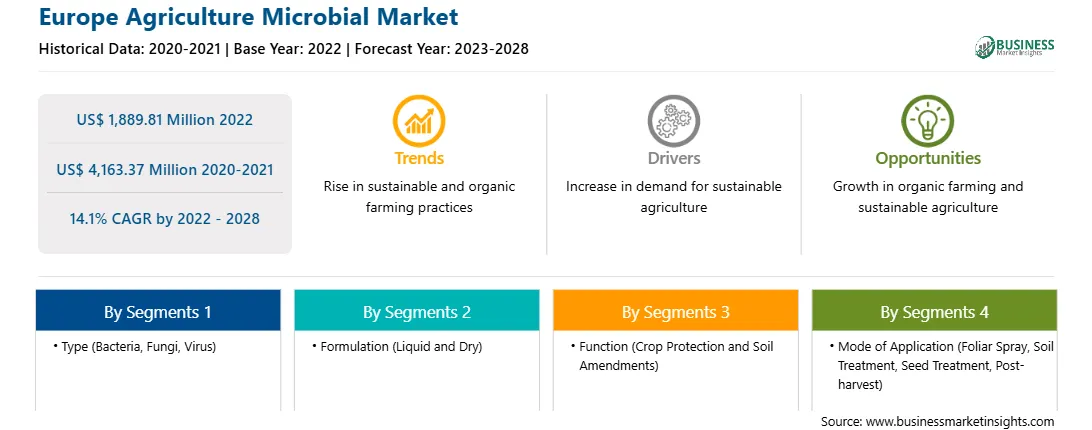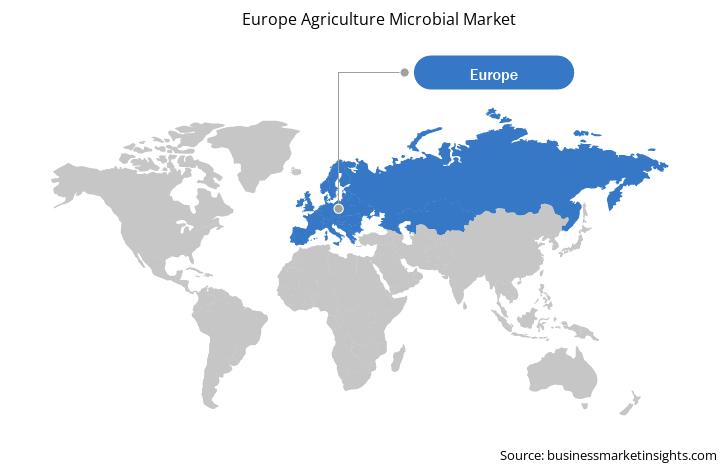Rise in Awareness Regarding Harmful Effects of Synthetic Chemicals
Using synthetic fertilizers and pesticides has shown detrimental effects on the environment and human health. Various efforts are taken to improve agriculture management practices, as synthetic pesticides and fertilizers are causing damage to the ecosystem. To reduce the chemical burden on the natural ecosystem, farmers are increasingly taking up agriculture microbial products, thereby driving the market. Furthermore, synthetic fertilizers and pesticides have long-term harmful effects on human health. The analysis of the epidemiological literature published between May 2018 and May 2019 states that exposure to synthetic chemicals is associated with adverse health effects in agriculture workers. The effects are highly related to genomic damage, cancers, oxidative stress, respiratory and neurological disorders, and metabolic and thyroid effects. With an increase in such effects on human health, the shift toward chemical-free pesticides and fertilizers has been observed, in turn, boosting the agriculture microbial market. The growing need for a more sustainable and ecological approach has surged many innovative ideas, including the uptake of sustainable agriculture practices. Moreover, leading companies and other governmental and non-governmental organizations promote sustainable agriculture methods by offering financial aid and subsidiaries for agriculture microbial products, which act as an important ingredient in sustainable agriculture practice. Thus, the rise in awareness regarding the harmful effects of synthetic chemicals is supporting the market.
Market Overview
The Europe agriculture microbial market is segmented into Germany, France, Italy, the UK, Russia, and the Rest of Europe. Europe has emerged as a potential market for agriculture microbial due to legislative mandates to reduce the dependency on synthetic chemicals. Governments of various European countries are engaged in implementing directives to promote the limited use of pesticides by implementing stringent regulations on synthetic chemicals. Additionally, growing environmental concerns in the region have been attributed to the shift toward sustainable agriculture. According to the European Biogas Association (EBA), the agriculture sector in the European Union contributes ~10% of the total greenhouse gas (GHG) emissions. The ongoing reform of the Common Agricultural Policy (CAP) offers an opportunity to improve environmental performance and agriculture sector resource efficiency.
Further, the inclination toward adopting organic farming is attributed to the growth of the agriculture microbial market in Europe. Organic farming has seen remarkable growth in the region in the past few years. According to Eurostat, in 2020, the total area under organic farming in European counties accounted for 14.7 million hectares of agricultural land. Further, the organic area made up 9.1% of total agricultural land in 2020. Growing organic farming in the region is attributed to increased consumer awareness about the products they consume by checking the quality and safety of food products. Consumer inclination toward organic products has encouraged farmers to use agricultural microbial on agricultural land, thereby reducing the chance of toxicity. Therefore, an increase in organic farming is anticipated to boost the demand for agriculture microbial during the forecast period.
Thus, the increased inclusion of agriculture microbial products to reduce the dependency on synthetic chemicals is anticipating lucrative opportunities to grow the agriculture microbial market in Europe.
Strategic insights for the Europe Agriculture Microbial provides data-driven analysis of the industry landscape, including current trends, key players, and regional nuances. These insights offer actionable recommendations, enabling readers to differentiate themselves from competitors by identifying untapped segments or developing unique value propositions. Leveraging data analytics, these insights help industry players anticipate the market shifts, whether investors, manufacturers, or other stakeholders. A future-oriented perspective is essential, helping stakeholders anticipate market shifts and position themselves for long-term success in this dynamic region. Ultimately, effective strategic insights empower readers to make informed decisions that drive profitability and achieve their business objectives within the market. The geographic scope of the Europe Agriculture Microbial refers to the specific areas in which a business operates and competes. Understanding local distinctions, such as diverse consumer preferences (e.g., demand for specific plug types or battery backup durations), varying economic conditions, and regulatory environments, is crucial for tailoring strategies to specific markets. Businesses can expand their reach by identifying underserved areas or adapting their offerings to meet local demands. A clear market focus allows for more effective resource allocation, targeted marketing campaigns, and better positioning against local competitors, ultimately driving growth in those targeted areas.
Europe Agriculture Microbial Strategic Insights

Europe Agriculture Microbial Report Scope
Report Attribute
Details
Market size in 2022
US$ 1,889.81 Million
Market Size by 2028
US$ 4,163.37 Million
Global CAGR (2022 - 2028)
14.1%
Historical Data
2020-2021
Forecast period
2023-2028
Segments Covered
By Type
By Formulation
By Function
By Mode of Application
By Crop Type
Regions and Countries Covered
Europe
Market leaders and key company profiles
Europe Agriculture Microbial Regional Insights

Europe Agriculture Microbial Market Segmentation
The Europe agriculture microbial Market is segmented into type, formulation, function, mode of application, and crop type and country.
Based on type, the market is segmented into bacteria, fungi, virus, and others. The bacteria segment registered the larger market share in 2022. Based on formulation, the market is segmented into liquid and dry. The liquid segment held the larger market share in 2022. Based on function, the market is segmented into crop protection and soil amendments. The crop protection segment held the larger market share in 2022. Based on mode of application , the market is segmented into foliar spray, soil treatment, seed treatment, and post-harvest. The foliar spray segment held the largest market share in 2022. Based on crop type, the market is segmented into cereals and grains, oilseeds and pulses, fruits and vegetables, and others .The fruits and vegetables segment held the largest market share in 2022. Based on country, the market is segmented into Germany, U.K., France, Italy, Russia, and Rest of Europe. Rest of Europe dominated the market share in 2022. BASF SE; Bayer AG; Certis USA LLC; Bio Works; Novozymes A/S; Chr. Hansen Holding A/S; Syngenta Group; Nufarm; Koppert B.V; and Marrone Bio Innovations,Inc. are the leading companies operating in the agriculture microbial in the region.
The Europe Agriculture Microbial Market is valued at US$ 1,889.81 Million in 2022, it is projected to reach US$ 4,163.37 Million by 2028.
As per our report Europe Agriculture Microbial Market, the market size is valued at US$ 1,889.81 Million in 2022, projecting it to reach US$ 4,163.37 Million by 2028. This translates to a CAGR of approximately 14.1% during the forecast period.
The Europe Agriculture Microbial Market report typically cover these key segments-
The historic period, base year, and forecast period can vary slightly depending on the specific market research report. However, for the Europe Agriculture Microbial Market report:
The Europe Agriculture Microbial Market is populated by several key players, each contributing to its growth and innovation. Some of the major players include:
The Europe Agriculture Microbial Market report is valuable for diverse stakeholders, including:
Essentially, anyone involved in or considering involvement in the Europe Agriculture Microbial Market value chain can benefit from the information contained in a comprehensive market report.